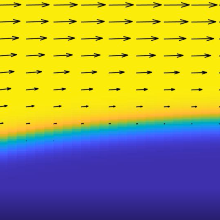New SFB 1313 publication by Carina Bringedal, Lars von Wolff, and Iuliu Sorin Pop , published in Siam - Society for Industrial and Applied Mathematics. >>> "Phase Field Modeling of Precipitation and Dissolution Processes in Porous Media: Upscaling and Numerical Experiments".
Abstract
We consider a model for precipitation and dissolution in a porous medium, where ions transported by a fluid through the pores can precipitate at the pore walls and form mineral. Also, the mineral can dissolve and become part of the fluid as ions. These processes lead to changes in the flow domain, which are not known a priori but depend on the concentration of the ions dissolved in the fluid. Such a system can be formulated through conservation equations for mass, momentum, and solute in a domain that evolves in time. In this case the fluid and mineral phases are separated by a sharp interface, which also evolves. We consider an alternative approach by introducing a phase field variable, which has a smooth, diffuse transition of nonzero width between the fluid and mineral phases. The evolution of the phase field variable is determined through the Allen--Cahn equation. We show that as the width of the diffuse transition zone approaches zero, the sharp-interface formulation is recovered. When we consider a periodically perforated domain mimicking a porous medium, the phase field formulation is upscaled to Darcy scale by homogenization. Then, the average of the phase field variable represents the porosity. Through cell problems, the effective diffusion and permeability matrices are dependent on the phase field variable. We consider numerical examples to show the behavior of the phase field formulation. We show the effect of flow on the mineral dissolution, and we address the effect of the width of the diffuse interface in the cell problems for both a perforated porous medium and a thin strip.
Read More: https://epubs.siam.org/doi/10.1137/19M1239003


